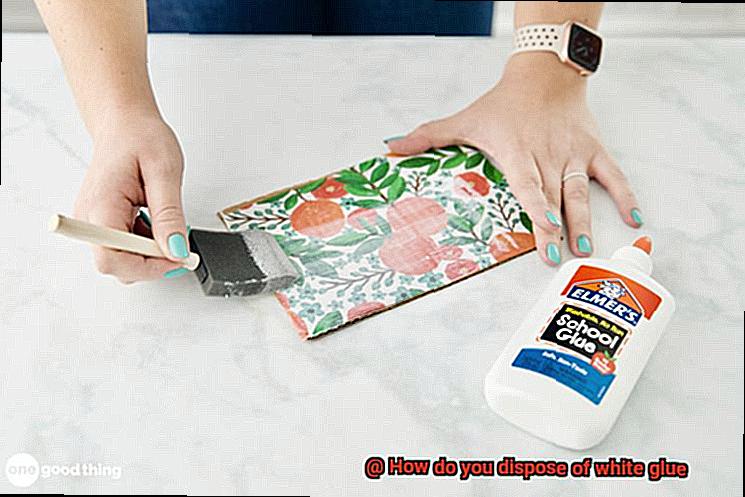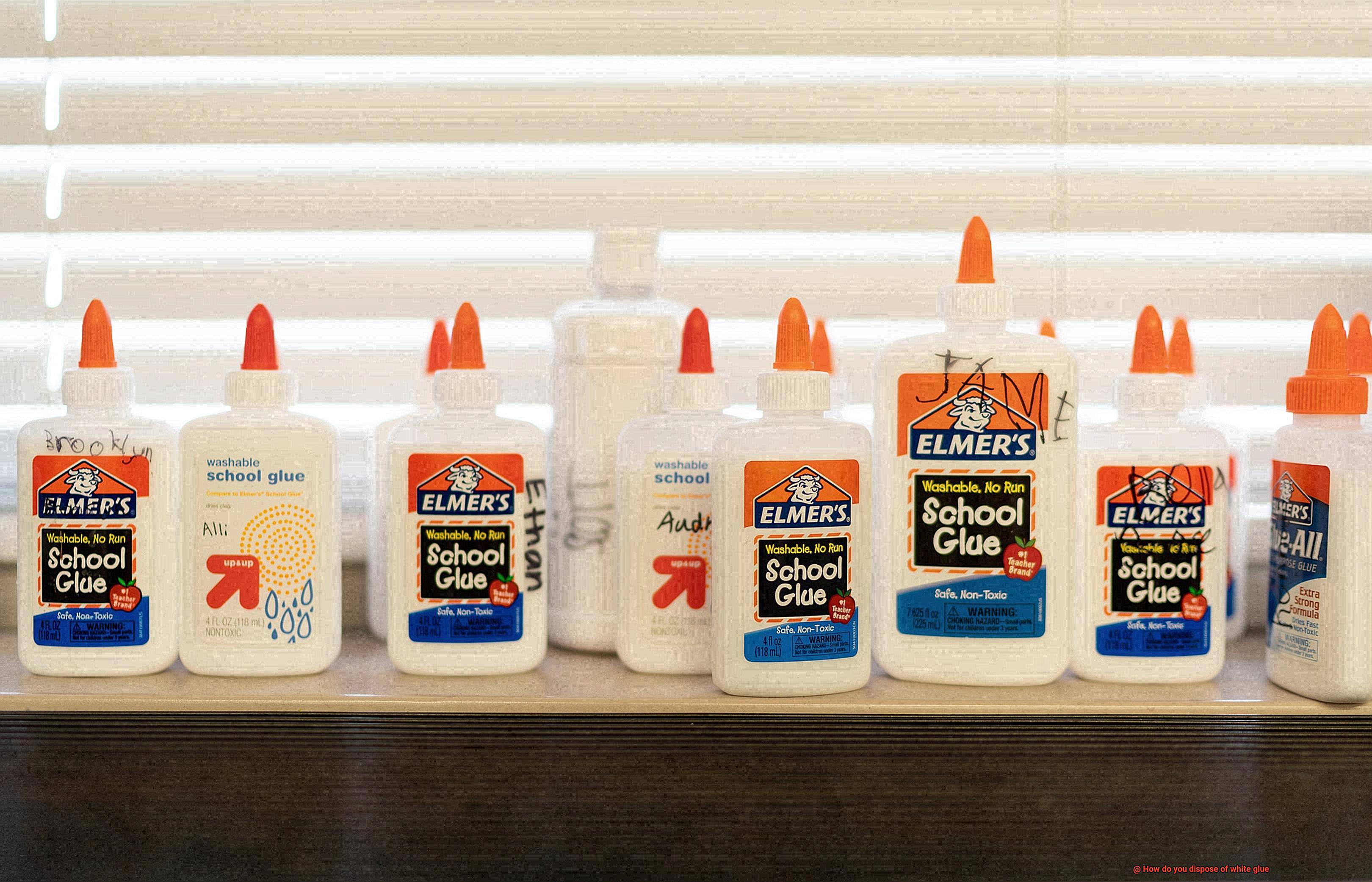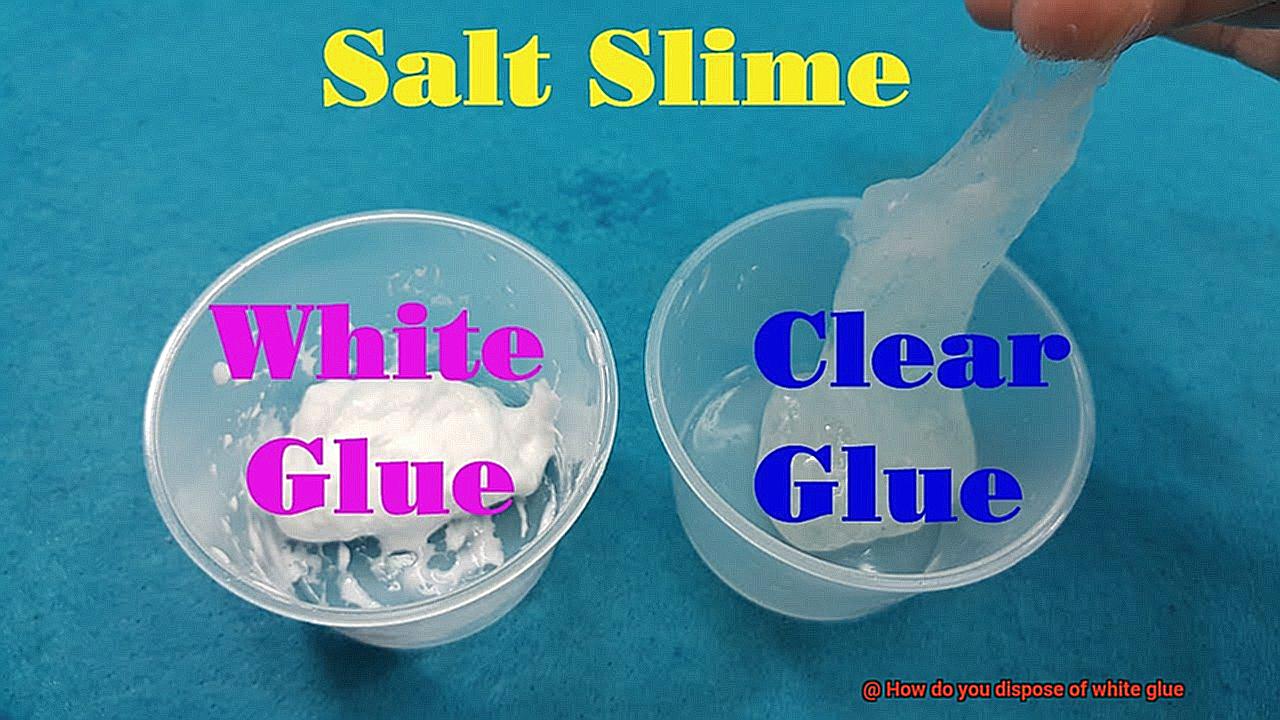Glue is a household staple that we all rely on for various purposes, from fixing broken items to creating art projects. However, when it comes to disposing of white glue, do you know what to do? You may be tempted to toss it in the trash or wash it down the drain, but these actions can have severe consequences for the environment.
White glue is a water-soluble adhesive commonly used on porous surfaces like paper, fabric, and wood. While it’s easy to clean up with water, proper disposal requires more effort than just pouring it down the drain. In fact, improper disposal can harm local water supplies and wildlife.
That’s why we’re here to answer the question: ‘How do you dispose of white glue?’ We’ll explore safe and efficient methods for getting rid of your unused glue. Plus, we’ll discuss the environmental risks associated with improper disposal. If you’re a fan of using white glue around your home or office, keep reading to learn how you can protect our planet by disposing of it properly.
a. What is White Glue?
Contents
If you’ve ever had to stick something together, chances are you’ve used white glue. But what exactly is it, and why is it so popular?
White glue, also known as school glue or PVA glue, is a water-based adhesive made from polyvinyl acetate (PVA) emulsion. What makes it so special is that it’s non-toxic and safe for children to use. Whether you’re working on an art project or a school assignment, white glue is an ideal choice.
One of the key benefits of white glue is its versatility. It can be used on a wide range of surfaces including paper, cardboard, wood, and fabric. It’s quick to dry and forms a strong bond, making it ideal for many different projects.

However, it’s important to note that white glue should never be ingested or applied to the skin. While it’s generally safe to use, some people may experience irritation or allergic reactions. As with any adhesive, always read the label carefully and follow the instructions.
When it comes to disposing of white glue, it’s best to let small amounts dry before washing them down the drain with plenty of water. Larger quantities should be disposed of in the trash, but make sure to check with your local waste management facility for specific guidelines on how to dispose of adhesives properly.
How to Dispose of White Glue
White glue is a versatile adhesive used in homes, schools, and offices for various projects. However, disposing of it can be a challenge, and improper disposal can harm the environment. As an expert in this field, I have compiled some environmentally-friendly methods to dispose of white glue. Here are five subtopics on the different ways to dispose of white glue without harming the environment:
Water-soluble White Glue:
Water-soluble white glue is easy to dispose of by washing it down the drain with plenty of water. However, do not use excessive amounts of water as it can cause clogging in the drain pipes. This method is a quick and effortless way to dispose of small amounts of white glue.
Let it Dry:
For non-water-soluble white glue, let it dry completely before you throw it away. This method ensures that there are no harmful chemicals released into the environment. You can leave the container open and let the glue air dry for a few days before disposing of it in the trash bin. This method is perfect for small to medium amounts of glue.
Recycling:
You can also recycle white glue bottles made of plastic by taking them to your local recycling center. Before recycling the bottle, ensure that there is no glue left inside by rinsing it with warm water. This method is ideal for large amounts of white glue or if you want to reduce waste.

Using Chemical Solvents:
If you have a lot of non-water-soluble white glue to dispose of, you can use chemical solvents such as acetone or nail polish remover to dissolve it. However, these solvents are highly flammable and should be used with caution. Never pour them down the drain as they can harm aquatic life and damage plumbing. This method is perfect for heavy-duty projects like construction.
Check with Your Local Waste Management Facility:
Some cities have regulations on how to dispose of certain types of adhesives like white glue. To be sure about how to dispose of white glue properly, check with your local waste management facility for specific guidelines. This method is ideal if you are unsure about the appropriate disposal method.
Washing it Down the Drain
Washing it Down the Drain”. While washing white glue down the drain may seem like the easiest way to dispose of it, it’s not the best option for our planet. In fact, white glue contains chemicals that can be harmful to aquatic life and can even cause blockages in pipes.
But don’t worry – there are plenty of eco-friendly alternatives. If you do choose to wash white glue down the drain, make sure to use plenty of water to dilute the glue and prevent pipe clogs. Hot water can also help break down the adhesive. However, if possible, it’s better to avoid pouring any amount of glue down the drain altogether.
Instead, opt for a more sustainable solution, such as using a paper towel or rag to wipe up any excess glue and dispose of it in the trash. If you have a larger amount of leftover glue, let it dry first before peeling it off surfaces and throwing it away. Additionally, many plastic glue bottles can be recycled – just check with your local recycling center for specific guidelines.
Letting it Dry Completely
Letting your white glue dry completely before throwing it away is an easy and eco-friendly solution that you can do right at home.
To start, make sure your glue is spread out as thinly as possible on a non-porous surface such as a plastic lid or a piece of wax paper. Remember, the thinner the layer of glue, the quicker it will dry. Don’t make the mistake of letting the glue dry in the container it came in, as this can clog up the nozzle and make the container unusable.
Once the glue is spread out, let it sit undisturbed in a well-ventilated area for at least 24 hours. Depending on how thick the layer is, it may take longer for the glue to fully dry. So be patient and resist the urge to touch it.
After waiting for the glue to dry completely, peel it off the surface it was on. The dried glue will become brittle and can be easily removed. Then, throw away the dried glue in your regular trash. It’s important to note that this method is only suitable for small amounts of white glue. If you have larger quantities to dispose of, it’s best to contact your local waste management facility for guidance on proper disposal methods.
Safety Precautions
White glue, also known as school glue or PVA glue, is a commonly used adhesive in households and classrooms. However, it can be hazardous if not handled with care.
First and foremost, it is essential to note that you should never dispose of white glue down the drain. This water-based adhesive can cause plumbing clogs and harm aquatic life if it enters the water supply. To avoid this, always dispose of white glue in your regular household trash.
Before tossing it in the bin, ensure that the glue is completely dry. The best way to do this is by letting it air dry for several hours or overnight until it becomes hard and brittle. Once it’s dry, you can safely dispose of it in your trash.
When using white glue, handle it with care to avoid any mishaps. Avoid getting the glue on your skin or clothing as it can be challenging to remove and may cause irritation or allergic reactions in some individuals. If you accidentally get glue on your skin, wash the affected area with soap and water immediately.
Moreover, keep white glue out of reach of children and pets as ingesting it can be harmful. Always store the glue in a secure location and follow the manufacturer’s instructions for use and disposal.
Benefits of Proper Disposal
White glue is an everyday item that many of us use for various purposes, from school projects to DIY crafts. However, what most people don’t know is that improper disposal of white glue can have devastating effects on the environment and human health. That’s why it’s essential to understand the benefits of proper disposal of white glue.
One of the most significant benefits of proper disposal of white glue is that it helps reduce pollution. When white glue is disposed of improperly, it can release toxic chemicals into the environment, contaminating soil, water, and air. This pollution can be harmful to both human and animal life. By using proper disposal methods such as recycling or reusing, we can help keep our environment clean and safe.
Another benefit of proper disposal of white glue is that it conserves resources. Improper disposal leads to wastage of resources such as energy, water, and raw materials used in the production process. By properly disposing of white glue, we can conserve these resources and reduce our carbon footprint.
Moreover, proper disposal of white glue has economic benefits. Recycling or properly disposing of white glue creates job opportunities in the waste management industry, promoting economic growth while also supporting a sustainable future.
Local Waste Management Regulations
White glue may seem like a harmless item, but improper disposal can have dire consequences for both the environment and human health.
It’s essential to check with your local authorities to determine the specific guidelines in your area as these regulations can vary depending on where you live. In some places, white glue may be considered a hazardous material and therefore cannot be disposed of in regular household waste. Instead, it may need to be taken to a hazardous waste disposal facility or collected by a specialized waste management service.
Even in areas where white glue is not considered hazardous, proper disposal techniques must still be followed. This includes sealing the container tightly and placing it in a separate bag to prevent any spills or leaks. By doing so, you not only reduce pollution but also limit the risk of harm to waste management workers who handle your trash.
It’s worth noting that some localities have recycling programs for certain types of glue containers such as plastic bottles or tubes, which can help promote sustainability. Check with your local recycling center to see if they accept these materials and how they should be prepared for recycling.
Common Mistakes to Avoid
But here’s the thing – these seemingly harmless actions can have a massive impact on the environment and your local waste management system.
Let’s start with pouring white glue down the drain. Sure, it may seem like an easy way to dispose of excess glue, but trust us when we say that it can cause significant problems for your plumbing and the environment. White glue contains chemicals that can clog pipes and cause blockages, leading to expensive repairs. And if it enters waterways, it can harm aquatic life.
Throwing white glue in the trash may appear to be a safe option, but it contributes to pollution and environmental damage. The plastic containers that often package white glue are not biodegradable, meaning they can take hundreds of years to decompose in landfills.
Burning white glue is another common mistake that you should avoid at all costs. Not only is it illegal, but burning white glue releases harmful fumes that pose a risk to both human health and the environment.
So how can you dispose of white glue properly? Firstly, let the glue dry completely before disposing of it in the trash. This allows it to harden and become less likely to cause issues in landfills or waterways. Another option is to check with your local waste management system to see if they have a hazardous waste disposal program that accepts white glue.
HpdRMwlBnuw” >
Also Read: How to Dissolve Kleenex? – Glue Things
Conclusion
White glue is a versatile household item that we all use for various purposes, from fixing broken items to creating art projects. However, when it comes to disposing of white glue, it’s crucial to do so properly to avoid harming the environment. Fortunately, there are several safe and efficient methods for getting rid of unused glue without causing harm to our planet.
For water-soluble white glue, simply wash it down the drain with plenty of water. However, non-water-soluble white glue requires a bit more attention. Let it dry completely before throwing it away or recycling the plastic bottle. If you have large amounts of non-water-soluble white glue, chemical solvents like acetone or nail polish remover can dissolve it effectively. But be cautious and never pour these solvents down the drain.
It’s important to handle white glue with care as it can cause irritation or allergic reactions if applied to the skin or ingested. Always store the glue in a secure location and follow the manufacturer’s instructions for use and disposal.
Proper disposal of white glue has many benefits, including reducing pollution, conserving resources, promoting economic growth and supporting a sustainable future. To ensure you’re doing your part in protecting our planet, check with your local waste management facility for specific guidelines on how to dispose of adhesives properly.
Avoid common mistakes while disposing of white glue by never pouring it down the drain or burning it. Instead, let the glue dry completely before disposing of it in your regular trash or recycling centers if possible.






